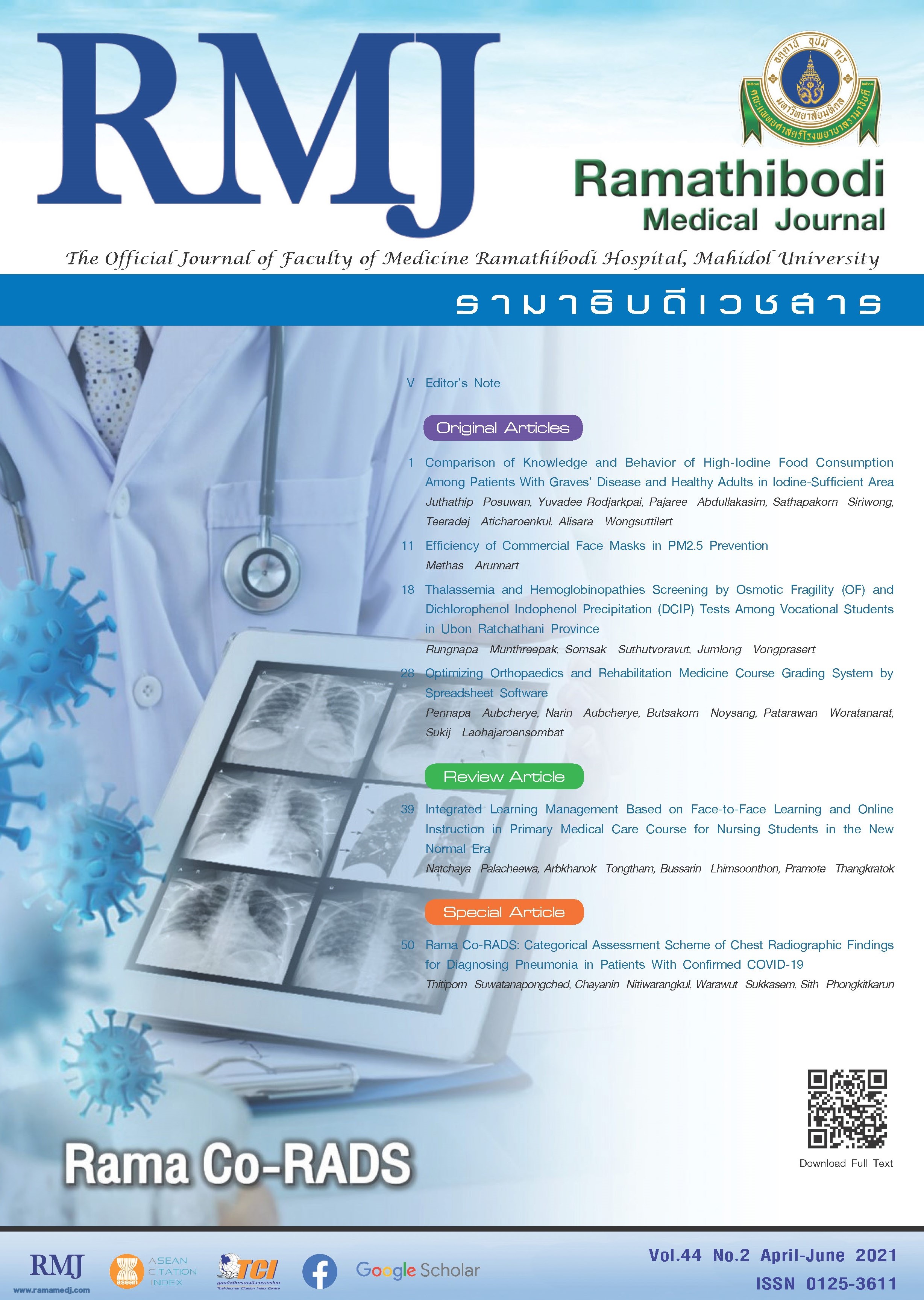Comparison of Knowledge and Behavior of High-Iodine Food Consumption Among Patients With Graves’ Disease and Healthy Adults in Iodine-Sufficient Area
DOI:
https://doi.org/10.33165/rmj.2021.44.2.249407Keywords:
High-iodine food, Graves’ disease, Iodine-sufficient areaAbstract
Background: Iodine is a required dietary supplement to solve iodine deficiencies; however, many food products may now have an excessive amount of iodine. This excess may be causing unexpected iodine-induced Graves’ disease.
Objective: To investigate the impact of high-iodine diets on adults diagnosed with Graves’ disease and healthy adults.
Methods: A case-control study was performed among 200 patients with Graves’ disease and 200 healthy participants in Chon Buri, Thailand, using cluster random sampling from November 2019 to March 2020. Data on iodine-rich food consumption were collected using a questionnaire. Data were analyzed using a chi-square test and multiple logistic regression.
Results: Patients with Graves’ disease significantly less knew of high-iodine food than the control group (P < .05), particularly in eggs, processed foods, ready-to-eat food, cod liver oil, and high-iodine vegetables. A frequent consumption of high-iodine food items, including fermented food (OR, 2.20; 95% CI, 1.20 - 4.02), ready-to-eat food (OR, 2.08; 95% CI, 1.02 - 4.22), high-iodine vegetables (OR, 1.72; 95% CI, 1.13 - 2.61), bakery (OR, 1.99; 95% CI, 1.10 - 3.64), iodine-supplemented sauces (OR, 1.79; 95% CI, 1.18 - 2.72), and iodized salts (OR, 1.62; 95% CI, 1.02 - 2.56) was higher in Graves’ disease patients.
Conclusions: In iodine sufficiency area, patients with Graves’ disease less knew and more frequently consumed high-iodine foods than healthy participants.
References
Tinna T, Ounjaijean S, Tongsong T, Traisrisilp K. Comparison of the effectiveness of universal and targeted iodine supplementation in pregnant women: a randomized controlled trial. Gynecol Obstet Invest. 2020;85(2):189-195. doi:10.1159/000506800
Katagiri R, Yuan X, Kobayashi S, Sasaki S. Effect of excess iodine intake on thyroid diseases in different populations: a systematic review and meta-analyses including observational studies. PLoS One. 2017;12(3):e0173722. doi:10.1371/journal.pone.0173722
Aghini Lombardi F, Fiore E, Tonacchera M, et al. The effect of voluntary iodine prophylaxis in a small rural community: the Pescopagano survey 15 years later. J Clin Endocrinol Metab. 2013;98(3):1031-1039. doi:10.1210/jc.2012-2960
Laurberg P, Cerqueira C, Ovesen L, et al. Iodine intake as a determinant of thyroid disorders in populations. Best Pract Res Clin Endocrinol Metab. 2010;24(1):13-27. doi:10.1016/j.beem.2009.08.013
Bürgi H. Iodine excess. Best Pract Res Clin Endocrinol Metab. 2010;24(1):107-115. doi:10.1016/j.beem.2009.08.010
Foppiani L, Cascio C, Lo Pinto G. Iodine-induced hyperthyroidism as combination of different etiologies: an overlooked entity in the elderly. Aging Clin Exp Res. 2016;28(5):1023-1027. doi:10.1007/s40520-015-0483-4
Zimmermann MB. Iodine deficiency and excess in children: worldwide status in 2013. Endocr Pract. 2013;19(5):839-846. doi:10.4158/EP13180.RA
Bureau of Nutrition, Department of Health, Ministry of Public Health. Implementation Guidelines of Prevention and Control of Iodine Deficiency Disorders for Public Health Workers. Samcharoen Panich (Bangkok); 2020. Accessed February 19, 2021. http://nutrition.anamai.moph.go.th/ewtadmin/ewt/nutrition/main.php?filename=iodine
Ershow AG, Skeaff SA, Merkel JM, Pehrsson PR. Development of databases on iodine in foods and dietary supplements. Nutrients. 2018;10(1):100. doi:10.3390/nu10010100
Rose HR, Zulfiqar H. Jod Basedow Syndrome. In: StatPearls. Treasure Island (FL): StatPearls Publishing; 2020. Accessed February 21, 2021. https://www.ncbi.nlm.nih.gov/books/NBK544277/
Tan L, Sang Z, Shen J, et al. Prevalence of thyroid dysfunction with adequate and excessive iodine intake in Hebei Province, People's Republic of China. Public Health Nutr. 2015;18(9):1692-1697. doi:10.1017/S1368980014002237
Szabolcs I, Podoba J, Feldkamp J, et al. Comparative screening for thyroid disorders in old age in areas of iodine deficiency, long-term iodine prophylaxis and abundant iodine intake. Clin Endocrinol (Oxf). 1997;47(1):87-92. doi:10.1046/j.1365-2265.1997.2271040.x
Konno N, Yuri K, Taguchi H, et al. Screening for thyroid diseases in an iodine sufficient area with sensitive thyrotrophin assays, and serum thyroid autoantibody and urinary iodide determinations. Clin Endocrinol (Oxf). 1993;38(3):273-281. doi:10.1111/j.1365-2265.1993.tb01006.x
Zaletel K, Gaberscek S, Pirnat E. Ten-year follow-up of thyroid epidemiology in Slovenia after increase in salt iodization. Croat Med J. 2011;52(5):615-621. doi:10.3325/cmj.2011.52.615
Lind P, Kumnig G, Heinisch M, et al. Iodine supplementation in Austria: methods and results. Thyroid. 2002;12(10):903-907. doi:10.1089/105072502761016539
Azizi F, Daftarian N. Side-effects of iodized oil administration in patients with simple goiter. J Endocrinol Invest. 2001;24(2):72-77. doi:10.1007/BF03343816
International Council for Control of Iodine Deficiency Disorders; UNICEF; World Health Organization. Assessment Of Iodine Deficiency Disorders and Monitoring Their Elimination: A Guide for Programme Managers. 3rd ed. World Health Organization; 2007. Accessed February 19, 2021. https://apps.who.int/iris/bitstream/handle/10665/43781/9789241595827_eng.pdf?sequence=1
World Health Organization. Urinary Iodine Concentrations for Determining Iodine Status in Populations. World Health Organization; 2013. Accessed February 19, 2021. https://apps.who.int/iris/bitstream/handle/10665/85972/WHO_NMH_NHD_EPG_13.1_eng.pdf?sequence=1
Bloom B, Engelhart M, Furst E, Hill W, Krathwohl D. Taxonomy of Educational Objectives: The Classification of Educational Goals. Handbook I: Cognitive Domain. Longmans; 1956.
Ballal S, Soundararajan R, Bal C. Re-establishment of normal radioactive iodine uptake reference range in the era of universal salt iodization in the Indian population. Indian J Med Res. 2017;145(3):358-364. doi:10.4103/ijmr.IJMR_1158_14
Haap M, Roth HJ, Huber T, Dittmann H, Wahl R. Urinary iodine: comparison of a simple method for its determination in microplates with measurement by inductively-coupled plasma mass spectrometry. Sci Rep. 2017;7:39835. doi:10.1038/srep39835
Restani P, Persico A, Ballabio C, Moro E, Fuggetta D, Colombo ML. Analysis of food supplements containing iodine: a survey of Italian market. Clin Toxicol (Phila). 2008;46(4):282-286. doi:10.1080/15563650701373788
de Benoist B, McLean E, Andersson M, Rogers L. Iodine deficiency in 2007: global progress since 2003. Food Nutr Bull. 2008;29(3):195-202. doi:10.1177/156482650802900305
Hiraiwa T, Ito M, Imagawa A, et al. Restriction of dietary iodine does not ameliorate the early effect of anti-thyroid drug therapy for Graves’ disease in an area of excessive iodine intake. J Endocrinol Invest. 2006;29(4):380-384. doi:10.1007/BF03344113
Polumbryk M, Kravchenko V, Pasichnyi V, Omelchenko C, Pachitskaya I. The effect of intake of sausages fortified with β-CD-I2 complex on iodine status and thyroid function: a preliminary study. J Trace Elem Med Biol. 2019;51:159-163. doi:10.1016/j.jtemb.2018.10.014
Luo J, Li C, Zhang X, Shan Z, Teng W. Reference intervals of the ratio of urine iodine to creatinine in pregnant women in an iodine-replete area of China. Biol Trace Elem Res. 2021;199(1):62-69. doi:10.1007/s12011-020-02133-8
Farebrother J, Zimmermann MB, Andersson M. Excess iodine intake: sources, assessment, and effects on thyroid function. Ann N Y Acad Sci. 2019;1446(1):44-65. doi:10.1111/nyas.14041
De Leo S, Lee SY, Braverman LE. Hyperthyroidism. Lancet. 2016;388(10047):906-918. doi:10.1016/S0140-6736(16)00278-6

















